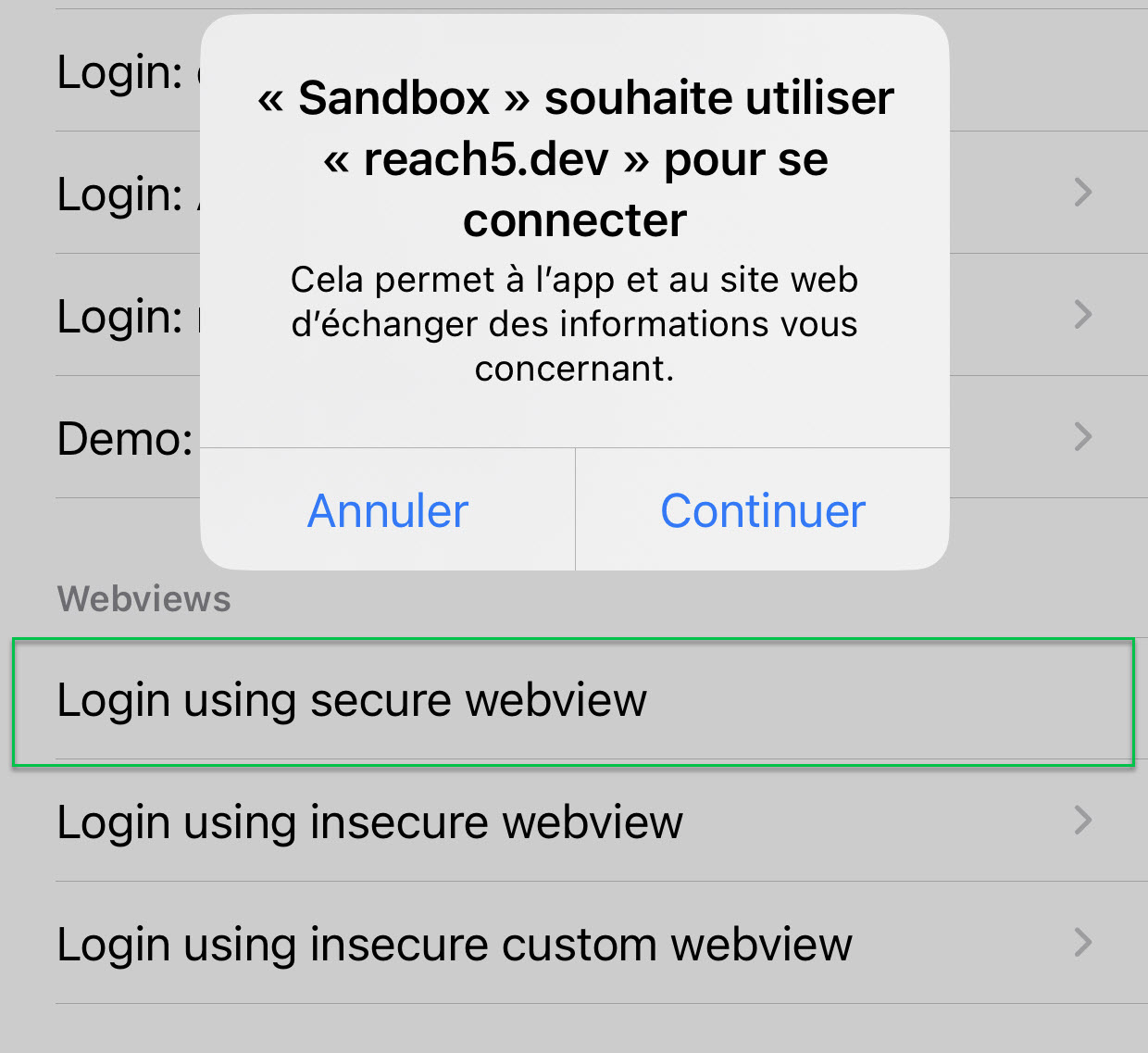webviewLogin
AppDelegate.reachfive().webviewLogin(WebviewLoginRequest(
presentationContextProvider
// optional
state,
nonce,
scope, (1)
))
| 1 | Scope isn’t explicitly required. If not provided here, it defaults to the scopes set up in the client configuration which is picked up when you initiliaze the iOS SDK. |
Description
Opens a secure webview through the authorization endpoint.
|
You must have configured a Login URL and enabled request orchestration tokens for your identity client. Orchestrated flows are supported from version |
-
If end-users have an active web SSO session, then the authorization endpoint immediately redirects to the application.
-
If end-users do not have an active web SSO session, they are redirected to the client’s Login URL for authentication.
When logging in with secure webview, a dialog pops up where you must select Continue and acknowledge that by continuing "This allows the app and the website to exchange information about you".

Usage
Because of the presentationContextProvider property, you must ensure that your UIViewController implements the ASWebAuthenticationPresentationContextProviding protocol.
To do this, add the following to your UIViewController:
func presentationAnchor(for session: ASWebAuthenticationSession) -> ASPresentationAnchor {
view.window!
}Examples
AppDelegate
.reachfive()
.webviewLogin(WebviewLoginRequest(
state: "zf3ifjfmdkj",
nonce: "n-0S6_PzA3Ze",
scope: ["openid", "profile", "email"],
presentationContextProvider: self
))
.onSuccess{ authToken in
// Get the profile's authentication token
}
.onFailure { error in
// Return a ReachFive error
}Parameters
| Parameter | Description | ||
|---|---|---|---|
A delegate that provides a display context whereby the system is able to present an authentication session to the user.
|
|||
The OAuth2 state value.
|
|||
An OIDC nonce value.
|
|||
The scopes granted to the profile. Make sure they are allowed by the client. Default scopes are the allowed scopes set up in the client’s configuration. |
Response
Type: Future<AuthToken, ReachFiveError>
AuthToken
The authentication token.
idToken |
The ID token JSON Web Token (JWT) that contains the profile’s information. |
||||||||||||||||||||||||||||||||||
accessToken |
The authorization credential JSON Web Token (JWT) used to access the ReachFive API. |
||||||||||||||||||||||||||||||||||
refreshToken |
The refresh token JSON Web Token (JWT) used to obtain new access tokens once they expire. This is only available when the |
||||||||||||||||||||||||||||||||||
tokenType |
The type of token. Always equal to |
||||||||||||||||||||||||||||||||||
expiresIn |
The lifetime in seconds of the access token. If |
||||||||||||||||||||||||||||||||||
user OpenIDUser |
The user’s information contained in the ID token.
|
ReachFiveError
Based on the problem, the ReachFiveError will be:
-
RequestError(requestErrors: RequestErrors)if it’s a bad request error.error
stringThe main error message.
errorId
stringThe identifier of the error.
errorUserMsg
stringThe user-friendly error message.
This property is translated according to the user’s browser settings. Currently supported languages: - Currently supported languages
-
-
ar- العربية Arabic -
de- Deutsch German -
en- English -
es- Español Spanish -
fr- Français French -
hu- Magyar Hungarian -
it- Italiano Italian -
jp- 日本 Japanese -
ko- 한국인 Korean -
nl- Nederlands Dutch -
pt- Portuguese -
ru- Ру́сский Russian -
sk- Slovenský Slovak -
zh-CN- People’s Republic of China Simplified Chinese -
zh-Hans- Simplified Chinese -
zh-Hant- Traditional Chinese -
zh-HK- Hong Kong Traditional Chinese -
zh-MO- Macao Traditional Chinese -
zh-SG- Singapore Simplified Chinese -
zh-TW- Taiwan Traditional Chinese
-
errorMessageKey
stringThe error message key.
errorDescription
stringThe technical error message.
errorDetails FieldError[]
field
stringThe field concerned by the error.
message
stringThe message error returned for the
field.code
stringThe code error returned for the
field.-
AuthFailure(reason: String)if the authentication has failed. -
AuthCanceledif the authentication was cancelled. -
TechnicalError(reason: String)if it’s an internal server error.